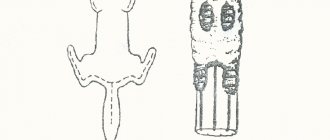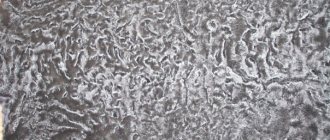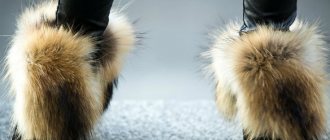Use of fur
On the sales market, designers have launched a large variety of products using mole fur, for example:
- fur coats;
- hats;
- raincoats;
- jackets
The fur of this animal attracted designers with its extraordinary softness, thickness and lightness, which adds shine to the products. Mole skins differ in quality depending on the subspecies. Thus, the fur of the Caucasian mole is most often used - it is widely used in the manufacture of clothing.
Mole fur
But there are also some disadvantages when using it:
Unique fur coats
Mole fur coats, which were widely popular in the 20th century, have now returned to fashion. A mole fur coat is considered stylish, looks beautiful, and provides its owner with comfort and warmth.
Since the animals are small in size, it is quite difficult to make a fur coat from mole skins. But thanks to modern technologies, the furs are so well tailored that the sewing of many parts becomes unnoticeable, and the fur itself plays with its tint and only adds to the impression that the fur coat is made of large parts, as in the photo.
Mole fur coat
Long models of mole coats are made extremely rarely, but medium-length or shortened models can be found much more often. Since the value of fur in the cost of a long model increases its cost, not every girl can afford such a fur coat. Although products of medium length are not cheap.
Having different shades and colors, the skins are still dyed in:
- ash gray with a blue tint;
- jet black;
- black-brown.
To make fur coats, wool is often sheared, giving it additional elegance and neatness.
Dark fur coat
Features of shooting and processing mole skins
Despite the fact that mole skins at first glance seem small and not impressive, they are used to make beautiful women's coats, jackets, stoles, and other fur products, and are used to trim costumes. The mole's hair sheds twice a year: in spring and autumn. In addition, in summer and winter, partial, so-called compensatory molting is observed on the skins of moles, when in certain areas of the body the hair that is worn and destroyed by friction against the walls of the burrow is replaced by a new one.
The most productive periods for mole fishing are mid-summer (June-July) and late autumn (from October until snow cover falls). At this time, the maximum number of moles usually ends up in traps, and their skins are of the highest quality. The carcass of a mole caught in a trap can quickly decompose at high temperatures and air humidity. First of all, the connection between the hair and the skin is disrupted, hair loss occurs, bald spots form, and the leather tissue loses its strength. The skin of a dead mole in a trap is damaged by some types of beetles that eat the corpses of dead animals, causing it to lose value and cannot be used for making fur. In this regard, the hunter must check the placed traps at least 2 times a day. More infrequent inspections reduce the efficiency of the fishery due to the low quality of the obtained skins. Removing the skin The mole skin is removed from the carcass at the fishing site. Experienced hunters remove the skin within one minute and usually do this on the fly as they walk from one pair of traps to another. The skin is removed from the carcass in a layer. The carcass is taken in the left hand, belly up and head towards you. At the middle of the lower lip, the end of the knife is inserted under the skin with the blade upward and a longitudinal incision is made in the skin exactly along the midline of the womb to the root of the tail. First, remove the skin from the belly. With your left hand, hold the edge of the skin at the cut, and with the thumb of your right hand, separate the tissues of the carcass from the skin, first in the rump part to the right and left of the cut line. The rump part of the carcass, freed from the skin, is taken in the left hand, and with the right hand, the removed section of the skin is grabbed, and the rest of it is smoothly pulled together. The connecting ligaments at the ears and eyes are cut with the end of a knife. The skins are transported to the place where they are straightened and dried in a bag or shoulder bag. To prevent them from forming into a dense ball and becoming warm from heating, they are placed with fresh grass or thin branches of deciduous trees. Rite: Mole skins do not need to be degreased. Only on some skins in the chest and armpits are fatty deposits found. They are carefully removed with a knife blade or wiped with a rough dry cloth. At the same time, adhered and dried lumps of earth are removed from the hair, first rubbing them on the hair between the fingers.
Preservation The skins are preserved using a fresh-dry method. Paired skins are straightened with the flesh up and secured with small nails on boards or wooden boards. The skin is given the shape of a quadrangle with a width to length ratio of 1:1.5.
Shooting and editing mole skins
Do not overstretch the skin, as it may tear or lose its natural shape. The straightened skins are dried indoors, away from a heat source, or outdoors, under a canopy. Small drops of fat may appear on the inside of dried skins, to remove which the skin is freed from nails and wiped from the inside with a dry rag or burlap. The processed skins are tied into a bundle, folded in pairs, flesh to flesh. In this position, the hair of the skins does not get dirty, and their leather tissue is better preserved from drying out and rancidity. Packs are stored in a cool, dry place.
The online skin store Three Skins offers you to buy skins at competitive prices.
Hats
Soft, velvety and delicate mole hats are an excellent choice for sophisticated girls. The value of hats made from the skins of these animals is associated with their durability, since the fur has a high dirt-repellent property. Even if you get caught in the rain wearing such a hat, it will still remain dry and clean.
All hats made from this fur are distinguished by their lightness. Everyone, tired of winter hats with their heaviness and volume, found an excellent alternative in the use of elegant hats made of mole fur.
Some winter models are trimmed on the inside, for example, hats with earflaps, with a fur fold on the visor. There are also completely moleskin caps that are beautifully iridescent.
Other products
Spring jackets and coats are excellent clothing for using the skins of these animals. Since fur is not highly heat-resistant, for warmer periods, products made from mole fur are a good choice for fashionistas who love to be the center of attention.
Whatever the unique models of outerwear, nevertheless, the use of mole fur is still in demand today. From the 20th century, original coats of a classic cut with strict straight sleeves, having an average length up to the buttocks, came to us.
Mole vest
Mole fur is often used to make collars or other fur accessories, be it lapels on coats or fur folds on the sleeves of leather jackets.
The use of these raw materials always gives the product greater prestige and effectiveness. Even the use of small inserts allows you to play up clothes in new, brighter colors.
The mole fishery supports the last of the Mohicans
It’s hard to say that the forests and fields of St. Petersburg are rich in fur-bearing animals. But the EARTH is absolutely rich in them.
It’s hard to say that the forests and fields of St. Petersburg are rich in fur-bearing animals. But the EARTH is absolutely rich in them. The environs of St. Petersburg are inhabited by hundreds of thousands, if not millions, of moles. At the same time, the dungeon dweller has a strong reputation as a wrecker in Russia. But only. Meanwhile, in the West, a coat made from the fur of this animal costs $2,000 or more. A malicious pest
A huge amount of time and money is spent annually on the fight against moles in Russia.
They are expelled and harassed using spring mole traps, sticky traps are placed in holes, landowners grow special bean cordons around their plots and try to scare off the moles using pinwheels and rattles. And one of the St. Petersburg companies is promoting to the local market a device in the form of a garden peg, which scares away moles using low-frequency sound waves. Desperate people will do anything. They say that one of the summer residents, furious because moles had once again dug up his carefully cultivated plantations, decided to eliminate the pests using a homemade explosive device. Having soldered a metal pipe on one side, he filled it with a mixture of sulfur and manganese, adjusted the wick, put the “grenade” into the hole and began to wait. There was still no explosion, the unfortunate man thought that the fuse had gone out and reached for his device. That’s when it all happened: as soon as the demolition man’s hand dropped below ground level, the “long-awaited” explosive device went off. The moles, of course, were not harmed, but the landowner lost several fingers. Fur-bearing animals
Until recently, the mole was considered not only a pest, but also a valuable fur-bearing animal.
Most animals have velvety black fur, but there are also gray, motley and white moles. The heyday of mole hunting began in 1924-1925. Moles were consistently among the leaders of the Soviet fur trade. According to the International Independent Ecological and Political Science University, in 1935, 31 million mole skins were harvested on the territory of the USSR. At the same time, the widest sections of the population were involved in the hunting process. “Before the summer holidays, all schoolchildren were given the task of destroying up to 20 rodent pests. The extracted chipmunk or mole skin was taken to the store. By the beginning of the school year, the seller sent to the school a list of who handed in how many skins,” said an experienced mole catcher. Domestic enterprises mass-produced fur coats from the skins of captured animals. Back in the early 1990s in the Pskov region, the procurement of this fur-bearing animal ranged from 101.5 thousand to 743.3 thousand skins per year. But gradually everything faded away. Nowadays Pavlovsky Park is the only place in the vicinity of St. Petersburg where you can still see mole catchers. The last mole catcher,
Alexander Dmitriev, a 70-year-old full-time mole catcher at the Pavlovsk Museum-Reserve, has been working in this position for 20 years.
He knows the park and its inhabitants thoroughly. He can talk endlessly about squirrels, ducks, hedgehogs, owls, tits, admire trees and even worms. He loves them all because they are useful and helpless in park conditions. But he has a short conversation with underground pests, through whose fault the rarest roses and the oldest spruce trees disappear. The old method of catching moles is simple and cheap: the cost is only for traps, no bait is required for catching. The devices are placed in the mole tunnel at the entrance and exit, the animal runs into an obstacle, and hello... True, park moles are very different from the unafraid forest moles. There are especially cunning and intelligent specimens that are caught only the third or fourth time, and only because that they become too lazy to dig workarounds. Alexander Grigorievich recalls that in Soviet times, mole hunting brought in a very good income: for a couple of skins at the collection points for raw materials they paid 50 kopecks, and for the season D from April to October D one could earn up to 4.5 thousand hard Soviet rubles in addition to the salary rubles Mole fur coats then cost 330 rubles. They were especially popular among Finnish and German tourists, who bought fur coats in huge quantities: they say that in the West, mole is considered an exclusive fur. But the golden “age” of mole fishing is a thing of the past. During the season, thousands of moles are still found in the park, but Alexander Dmitriev has nowhere to take them. The experienced mole catcher was invited to the parks of Pushkin and Petrodvorets, where there were no specialists left, but Dmitriev did not abandon Pavlovsk. “If it weren’t for my pension, free travel, habit and craving for walks in nature, I would have given up this business,” the hunter sighs. I want a mole
At the same time, the demand for mole fur still exists. “This is wonderful fur, delicate, flexible and light. It's a pity that no one is working on it now. I would sew chic coats. Of course, you will have to tinker with the mole, but it is not intended to be rolled downhill and carried both to the feast and to the world. I make exclusive coats from the May hamster, which looks like a field mouse. We get hamster fur from Germany, where this business has deep roots,” commented Irina Tantsurina, head of the IT fashion house, specializing in fur products. (D.R., D.G.)
Select the fragment with the error text and press Ctrl+Enter
News Media2
We discuss the news here. Join us!










